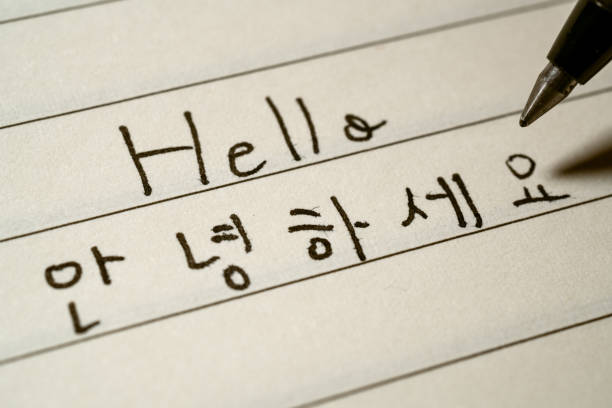The dialogue is first written in Korean (you have to know how to read Hangeul – the Korean alphabet) because there is no romanized transcription), then it is translated into English. A table then resumes the same elements, but sentence by sentence, with in the left column, the text in Korean, and in the right column, the English translation. Then follow some notes ( study notes ) and a list of important vocabulary to remember. The layout of the book is identical from start to finish, there is no image to embellish the text, no exercises. You can print it, as I did by the way, but here the text version is only the support of the audio version,
Essential Korean Vocabulary
Korean is a language spoken in Korea , in the border districts of the People’s Republic of China ( Yanbian ) and in emigrant communities (notably in Japan , China ( Beijing , Shandong ), Russia , Australia , United States , in France , etc.), and is the official language of North Korea and South Korea .
The classification of Korean is still controversial. Most linguists consider it an isolate , while others group it into a hypothetical Altaic family . Some similarities with Japanese have been noted .
The alphabet used to write Korean is Hangeul , created in the 15th century and made official in the 19th century ; the hanja ( sinograms used in this language) are also used, a fairly large part of the lexicon being of Chinese origin (at least outside the current vocabulary).
The language extends over a territory comparable to that of Italy, approximately 301,000 square kilometers, including approximately 220,000 square kilometers for the two Koreas combined, approximately 42,000 square kilometers for the Chinese prefecture of Yanbian (province of Jilin) and the rest partly on three other Chinese provinces.

Writing system
Korean used ” hanja ” (Korean pronunciation of the Chinese word hanzi designating Han Chinese characters – often called ” sinograms ” in French – very similar to those used under Imperial China, the Republic of China (Taiwan) and the People’s Republic of China , in Japan , in Singapore , or even formerly in Vietnam ) from the 6th century to the beginning of the 20th century . Since the beginning of the 20th century, Chinese writing has been replaced by a writing specific to Korea and called hangeul . This is aalphabet created around 1443 under Sejong the Great 12 , then banned from 1504 by his successor, Yeonsangun ; these characters will therefore be banned for most of the Joseon period (1392 – 1910), before being rehabilitated in 1894 and made official at the end of World War II . Nevertheless, in South Korea, academic circles continue to use the spelling combining the two writing systems, using hanja for the notation of words of Chinese origin. Unlike Chinese characters, Hangeul is a phonetic script with syllabic demarcation ., each Hangeul character therefore represents a syllable, itself composed of two to four letters, each of which represents a phoneme .

The Hangeul alphabet consists of 24 letters: (14 consonants and 10 vowels). It is used by grouping the letters by syllables occupying square blocks, at the rate of 2 to 4 letters per syllable. The shape of the consonants corresponds to the morphology of the organs of phonation, that of the vowels uses three symbols of Taoist origin (i.e. the point or short line, the vertical line and the horizontal line, which respectively represent the Sun , Man and Earth).See also Discover Hamdeok Beach
Modern Korean is written with spaces between words, unlike other languages like Chinese or Japanese . Korean punctuation uses Western punctuation marks, although they are used much more sparingly than in the West. Traditionally, Korean was written in columns from top to bottom, arranged right to left (like Traditional Chinese), but it is now written in rows left to right, arranged top to bottom (except in poetry where the format traditional is sometimes retained).
Grammar, syntax and usages

Since Korean is an agglutinative language , its system is very different from that of English.
The language follows the SOV typology , that is to say “Subject Object Verb”. Moreover, the determiner is placed before the word it determines. There is no article , no gender , no number ; the verbs are not conjugated according to the person (je, tu, il…) but they integrate many determinations, such as the aspect, the time, or the degree of politeness; invariant particles indicate the function of the word in the sentence. The connectors between two clauses are integrated into the verb of the first clause to be connected.
Degrees of politeness are often expressed in Korean by the suffixes added to the verb; they differentially express respect and humility.
Book
100 Korean Dialogues (200 Korean Dialogues)

200 Korean Dialogue Series by LIKE TEST PREP Basic and intermediate level Korean Learners can master the Daily Korean language very easily. The 200 situation dialogues include over 1,140 key sentences. Formal language commonly used by Korean adults is used. Various topics from greetings, school life, shopping to business deals are all covered. You should be able to read Hangeul (Korean Writing System) to make good use out of this book. *Each booklet contains only 20 dialogues.* Free mp3 files at www.liketestprep.com.
Did you like this article? Do not hesitate to share it on social networks and subscribe to Discover the World on Google News to not miss any articles!